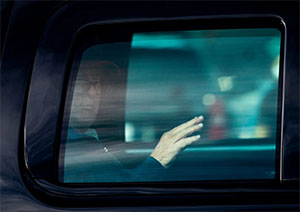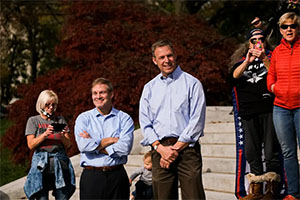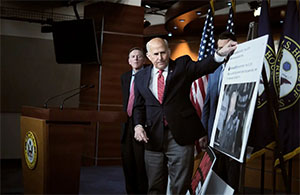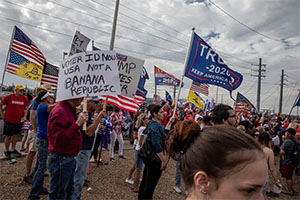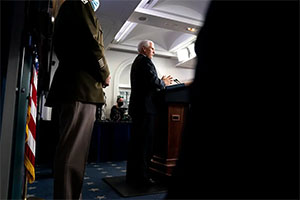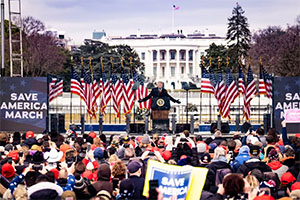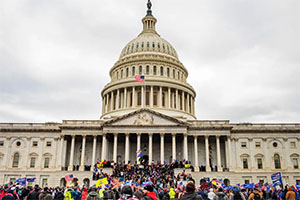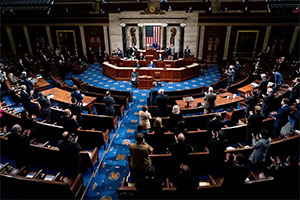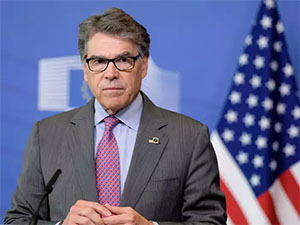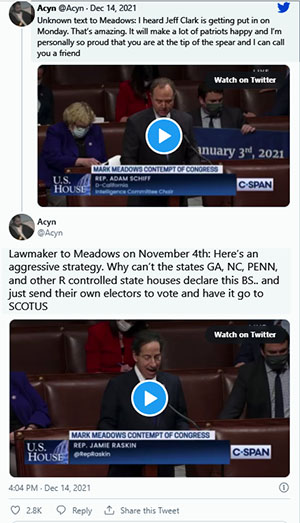The Harder Right: An Analysis of a Recent DoD Inspector General Investigation and Other Matters
by Colonel Earl G. Matthews, U.S. Army
December 1, 2021
May we ever choose the harder right, instead of the easier wrong.
-- Thomas Monson
The purpose of this memorandum is to outline and detail the myriad inaccuracies, false or misleading statements, or examples of faulty analysis contained in a recent publicly released Department of Defense Inspector General (DoDIG) report of its investigation into the Department of Defense’s actions leading up to and in response to the violent assault on the U.S. Capitol which occurred on 6 January 2021. This memorandum will also detail a series of false and/or misleading statements or documents deliberately made or submitted to the DoDIG and/or to the House Oversight and Reform Committee by senior officers of the United States Army1. This memorandum will conclusively show that at least two general officers of the Army engaged in repeated violations of 18 U.S.C. §§ 907, 1001, 1621. One of these general officers now leads an Army Service Component Command.2 The other will soon be nominated to lead an Army Command.3
Although written in the third person, the recollections expressed are those of Major General (Retired) William J. Walker, U.S. Army, who served as Commanding General of the District of Columbia National Guard on the date in question, and Colonel Earl G. Matthews, U.S. Army, who then served as his Staff Judge Advocate. This memorandum was drafted primarily by Colonel Matthews with the assistance of current and former D.C. National Guard officers who were continuously with MG Walker during the afternoon and evening of 6 January 2021, or who otherwise supported our response to the attack on the Capitol. This memorandum is drawn from the contemporaneous notes and emails of these soldiers and airmen and from their individual and collective memories.
Inspector General investigations are usually and appropriately accorded great deference because they are normally unbiased, independent, contain careful analysis of facts and circumstances, and because they make determinations as to the credibility, veracity and biases of particular witnesses, based on the preponderance of the evidence. Unfortunately, the DoDIG report on its investigation into DoD actions leading up to and during the 6 January attack was marked by few of these characteristics.
The DoDIG report relied heavily on close associates of LTG Walter Piatt and other Army Staff principals and the DoDIG failed to interview numerous District of Columbia National Guard personnel with highly relevant information. The DoDIG Report eventually adopted a narrative formed and developed by LTG Piatt, and his close associates, and is fundamentally flawed as a result.
The DoDIG report is replete with factual inaccuracies, discrepancies and faulty analysis. It relies on demonstrably false testimony or statements. The focus of this memorandum is on the discrepancies and falsehoods that DoDIG relied on to produce its report. The danger is that if this report, with its glaring errors and wholesale adoption of the Army company line, is accorded the deference typically afforded inspector general investigations, the report will become part of the historical record and a false narrative will have been as adopted fact. Discerning what happened on 6 January is too important to get wrong. If we do not fully comprehend and analyze what occurred on 6 January, the danger is that history will repeat itself. Our collective goal as a government and an American people should be to ensure that what occurred on 6 January does not happen again.
MG Walker’s view is that words matter, accuracy matters and precision matters. All too often the DoDIG Report lacked accuracy and precision.
A plausible argument can be made that the imprecision and inaccuracy begins with the title of the DoDIG report itself. The report is titled “ Review of the DoD’s Role, Responsibilities, and Actions to Prepare For the Protest and Its Aftermath at the U.S. Capitol Campus on January 6, 2021.”4 However, what occurred at the Capitol on 6 January was no mere “protest,” it was a riot and an assault on our democracy which occurred at the very seat of government. To not call it what it was is to minimize the importance and gravity of what occurred.
A Review of Key Events
Beginning at 1:49 p.m. on 6 January 2021, MG Walker began to receive a series of frantic telephone calls from the then Chief of the U.S. Capitol Police (USCP), Steven Sund informing MG Walker that the security perimeter at the U.S. Capitol had been breached by hostile rioters. Chief Sund, his voice cracking with emotion, indicated that there was a dire emergency on Capitol Hill and requested the immediate assistance of as many D.C. National Guard personnel as MG Walker could muster at the intersection of New Jersey and Louisiana Avenues, where law enforcement personnel from various local and federal law enforcement partners were assembling to assist and support U.S. Capitol Police efforts to restore order at the Capitol. MG Walker immediately made the Secretary of the Army aware of Chief Sund’s request and requested permission to assist USCP. At roughly 2:30PM on January 6, 2021, Dr. Christopher Rodriguez, Director of the District of Columbia Homeland Security and Emergency Management Agency (DCHSEMA) established a telephone bridge and invited MG Walker, Secretary of the Army, Ryan McCarthy, MPD Chief Robert Contee, USCP Chief Steve Sund, D.C. Deputy Mayor Dr. Roger Mitchell and U.S. Secret Service Uniformed Division Chief Thomas Sullivan to join. Conference call participants were informed that Secretary McCarthy was not available for the conference call as he had gone to see the Acting Secretary of Defense. McCarthy did not participate in the call. However, Lieutenant General Walter Piatt, Director of the Army Staff and Lieutenant General Charles Flynn, the Army’s Deputy Chief of Staff for Operations, were both on the call. As was Colonel John Lubas, Executive Officer to the Secretary of the Army. Additionally, Brigadier General Aaron Dean, the Adjutant General of the D.C. National Guard, Colonel Earl Matthews, Staff Judge Advocate of the D.C. National Guard, Command Sergeant Major Michael Brooks, the DCNG Senior Enlisted Advisor, and 1St Lieutenant Timothy Nick, MG Walker’s aide-de-camp, all joined MG Walker in his office at the D.C. Armory for this 2:30 p.m. conference call.
During the 2:30PM conference call, Chief Sund of the USCP pleaded for the immediate support of the D.C. National Guard at the U.S. Capitol as the security perimeter at the Capitol was being breached at that very moment. Chief Contee reinforced Chief Sund’s request. Chief Contee asked Chief Sund aloud if he was requesting immediate D.C. National Guard support at the Capitol. Chief Sund replied “Yes”. Chief Contee then asked LTG Piatt if the D.C. Guard would be sent to the Capitol. LTG Piatt stated that it would not be his best military advice to recommend to the Secretary of the Army that the D.C. National Guard be allowed to deploy to the Capitol at that time. LTG Piatt stated that the presence of uniformed military personnel could inflame the situation and that the police were best suited to handle the situation. Both LTGs Piatt and Flynn stated that the optics of having uniformed military personnel deployed to the U.S. Capitol would not be good.
Chief Contee then stated that he would inform the Mayor (D.C. Mayor Muriel Bowser) that the Army was refusing to send the National Guard to the Capitol and that he would ask her to convene a press conference to make this refusal known. LTG Piatt then asked Chief Contee to please not do this. Piatt stated that the request for Guard presence was not being refused and he had no power to deny or approve the request, only that he would not recommend approval to his civilian leadership. Piatt and Flynn recommended that Contee identify locations away from the Capitol where D.C. National Guard personnel could relieve MPD personnel of traffic duties, allowing more MPD personnel to surge to the Capitol. LTG Flynn also stated that the best use of D.C. National Guard personnel would be to free up MPD personnel by performing non-law enforcement traffic duties away from the Capitol. LTGs Piatt and Flynn recommended the D.C. National Guard develop a plan to support MPD at locations other than the Capitol. The telephone call that began at 2:30PM ended at approximately 2:55PM. LTG Flynn then directed that a secure video conference bridge be established between the Army Staff and the D.C. National Guard Leadership.
At approximately 3:05PM, MG Walker joined from his office the secure videoconference hosted by LTG Charles Flynn. Present with MG Walker were BG Dean, COL Matthews, 1LT Nick and CSM Brooks. This secure video teleconference would be continuous until around 5:15PM. Personnel in this teleconference included LTG Piatt, LTG Flynn, later General James McConville, Chief of Staff of the Army, LTG Leslie Smith, Inspector General of the Army, BG Matthew D. Smith, Mr. Casey Wardynski, Assistant Secretary of the Army for Manpower and Reserve Affairs, Wardynski’s deputy, Mr. Marshall Williams, and numerous others who joined and left the call as necessary. This teleconference was used to share information that was received from various sources by the D.C. National Guard or Army leadership. Army leaders on the call provided a situational update to GEN McConville. During this call, at 5:08PM, GEN McConville informed MG Walker and his leadership team that the Secretary of Defense had authorized the D.C. National Guard to deploy to the Capitol in support of the USCP.
Getting Facts Consistently Wrong on the 2:30PM Phone Conference
The DoDIG report consistently gets basic information incorrect as to events that transpired during the day on 6 January. The actual participants on the 2:30 p.m. conference call in which USCP Chief Sund and MPD Chief Contee, and others, pleaded for D.C. National Guard assistance is but one example. Although the call was arranged through the Secretary of the Army’s Executive Officer, COL John Lubas, MG Walker and the other non-Pentagon based participants in the call were told McCarthy was unavailable as he had gone to the Acting Secretary of Defense’s office.
The DoDIG report incorrectly indicates that McCarthy was an active participant on the call and that he spoke for roughly 5 minutes, before departing. During these 5 minutes, McCarthy was able, according to the DoDIG report, to “hear and acknowledge the urgent request from Mr. Sund and Mayor Bowser.” In reality, McCarthy could not have heard from Bowser during the 2:30 p.m. call because she did not participate in the call. Further, there was no indication that she was listening to the call silently. The DoDIG got this important point wrong. Active participants from the D.C. government during the call included Chief Contee, Dr. Rodriguez and Deputy Mayor Mitchell, but not Mayor Bowser. The only active participants in the call from Army headquarters were LTG Piatt, LTG Flynn and COL Lubas. COL Lubas only spoke to announce that McCarthy could not participate and to introduce Piatt and Flynn. The DoDIG report, however quotes several unnamed “Army witnesses” who consistently observed things that did not actually occur during the 2:30 p.m. call:
A supposed witness involved on the call is quoted as saying “Mayor Bowser and Chief Contee were frustrated that LTG Piatt told them that “Mr. McCarthy was getting the approval from Mr. Miller rather than saying, ‘Yes, we’re coming.’”
The DoDIG further notes “according to an Army witness on the call, Mayor Bowser made the statement about telling the media the Army denied the USCP request”
An unnamed witness to the 2:30 p.m. call stated “Mr. McCarthy asked MG Walker how quickly the QRF could respond MG Walker said that the QRF could move in 20 minutes.”
LTG Piatt incorrectly told the DoDIG that Secretary McCarthy directed MG Walker to move the QRF to the Armory during the 2:30PM conference call. This could not have occurred as McCarthy did not speak during the conference call and McCarthy was with the Acting Secretary of Defense at the time in question.
LTG Flynn is portrayed by the report as having listened to the 2:30PM conference call for “a couple of minutes,” not saying anything and then leaving to establish a video conference. The report states that “Army witnesses” confirmed that LTG Flynn’s participation was minimal. These may have been some of the same “Army witnesses” who, according to open press reporting, repeatedly and strenuously denied to the press for days that Flynn was even a participant on the 2:30PM conference call which occurred on 6 January. MG Walker conversely recalls that LTG Flynn was an active participant on the call who stayed to the end of the call and that Flynn commented on the negative optics that would ensue from the presence of uniformed military personnel at the Capitol. Flynn wanted the DCNG to develop a plan to have D.C. National Guard personnel relieve MPD elements at locations away from the Capitol in order to free up MPD resources to go to the Capitol.
According to the DoDIG report, “two Army witnesses” claimed that LTG Piatt asked questions during the 2:30 phone conference such as “what was happening at the Capitol, what tasks DCNG personnel would perform, whether they should be armed, who the QRF would align with, and where the QRF would assemble once they arrived at the Capitol”? An Army witness claimed that “no one on the conference call could answer LTG Piatt’s questions.” This allegation is false on its face and does not withstand basic parsing. Chief Sund, Chief Contee and Chief Sullivan, of the U.S. Secret Service Uniform Division, where relaying real-time reports of events at the Capitol from their respective police personnel arrayed there. The request for DCNG personnel at the Capitol came from Chief Sund, who was on the call. Sund knew exactly what mission he wanted the DCNG personnel to perform was. Sund wanted as many riot-equipped (helmets, body armor, shin guards, batons and shields) D.C. National Guard personnel as possible to report to the Capitol where they would assist USCP personnel in re-establishing the security perimeter which had been breached. Chief Sund had previously provided a link-up location where DCNG personnel should report to the USCP, the corner of New Jersey & Louisiana Avenues. There was never any contemplation or expectation by Chief Sund or Chief Contee that the requested DCNG would be equipped with firearms. The DCNG personnel would essentially perform the same roles they performed at Lafayette Square, along the National Mall, and other locations around Washington, DC during the civil unrest which followed the murder of George Floyd in the summer of 2020. The DCNG was a seasoned forced when it came to civil disturbance response operations, having conducted these missions, or prepared to conduct such missions, extensively over the previous 6 months. As MG Walker stated to the DoDIG when interviewed, the DCNG operational plan was to get as many riot gear-equipped Guardsmen on buses and to the Capitol, as soon as possible, where they would form up and take direction from MPD and/or USCP.
A Question Raised By the McCarthy-Miller Meeting
The DoDIG report indeed raises more questions than it answers. According to the report, at 2:30PM on 6 January, at roughly the same time that the conference call was occurring between LTGs Piatt and Flynn, Chief Sund, Chief Contee, DCNG leaders and others, Secretary McCarthy was meeting with Acting Secretary of Defense Miller. According to the DoDIG report, during their 2:30PM meeting, “McCarthy told Miller that the DCNG needed to mobilize everything and move to the Capitol as quickly as possible, and Mr. Miller immediately agreed.” The report goes on to state that “Miller ordered McCarthy to mobilize all of the DCNG’s 1100 personnel at approximately 3:04 p.m.”. Miller told the DoDIG that his 3:04PM order “gave McCarthy the approval and guidance he needed to mobilize the DCNG to help the USCP and MPD, and that Walker would immediately employ the QRF.” When asked by the DoDIG whether Miller’s order to mobilize the entire DCNG included approval to deploy DCNG personnel immediately to the Capitol to support the MPD and the USCP, McCarthy replied, “It did.”
The DoDIG report glosses over this crucial point. Miller claims he gave McCarthy full discretion to employ the DCNG in force to the Capitol at 3:04PM. For some reason , however, McCarthy felt the need to go back to Miller to report a so-called plan of deployment. It is not clear, whether Miller directly asked McCarthy to come back with a plan, or whether McCarthy simply sought buy-in from Miller because he did not want to be responsible for making the decision to deploy DCNG personnel on his own. The DoDIG does not address whether it asked Acting Secretary Miller if McCarthy was required to submit a plan to address the ongoing emergency then extant at the Capitol, or whether McCarthy simply chose to bring back a plan for approval. Miller’s statement to the DoDIG and his testimony to Congress would indicate that Miller believed that his further concurrence or approval, after his 3:04 PM direction to McCarthy to mobilize the DCNG, was not necessary before the DCNG could deploy to the Capitol. On May 12, 2021, in his sworn testimony before the House Oversight and Reform Committee, in response to questioning by Representative Ocasio-Cortez, former Acting Secretary Miller stated that MG Walker had “full authority. . .in my mind at 3:04.” Later in the same hearing, in response to questioning by Representative Hank Johnson, former Acting Secretary Miller stated, that Walker had “all the approval and authorities he needed at 3:04 when the order went out.” Secretary McCarthy however, believed he did not have the authority and approval he needed at 3:04 PM. The DoDIG does not acknowledge or address this obvious disconnect.
McCarthy supposedly briefed his “plan” to deploy the DCNG to Miller at 4:30PM, nearly 90 minutes after Miller, according to Miller’s statement to the DoDIG and his sworn testimony to a congressional committee, gave McCarthy full authorization to deploy the DCNG to support the MPD and USCP at the Capitol.
Another Fictious Phone Call
The DoDIG report claims that:
Mr. McCarthy left Mr. Miller’s office and called MG Walker at approximately 3:05 p.m. Mr. McCarthy did not want to send the DCNG to the Capitol without a plan he could present to Mr. Miller. A witness told us Mr. McCarthy and MG Walker discussed how many personnel were already at the Armory and where the DCNG could replace or reinforce MPD officers, freeing the MPD to respond to events at the Capitol in greater numbers. Mr. McCarthy directed MG Walker to recall DCNG personnel to the Armory, including the QRF at JBA and those already supporting the MPD at Metro stations.5 He ordered all personnel be equipped with riot shields and batons, and for MG Walker to prepare a “hasty” plan to support law enforcement at the Capitol.
The above recitation of events, cited as fact by the DoDIG, does not withstand even light scrutiny. MG Walker had directed that the QRF move from Joint Base Andrews to the Armory on his initiative in advance of 3:05PM (DCNG records show 14:12). Further, all D.C. National Guard personnel preparing to go to the Capitol were already fully kitted out with riot gear.6
MG Walker categorically denies that Secretary McCarthy called him at 3:05PM on 6 January. MG Walker at that time was in the midst of a video teleconference with LTG Piatt, LTG Flynn and senior Army leaders, and DCNG key leaders, discussing events at the Capitol and potential DCNG responses thereto. MG Walker would have of course prioritized a call from the Secretary of the Army, his direct and immediate superior, if it had come, but it did not. The above passage, posited as a fact by the DoDIG, apparently does not rely on the firsthand statements of Secretary McCarthy or MG Walker, but the recollection of an anonymous witness. MG Walker maintains that this phone call did not occur. Further, the idea that the DCNG should plan to replace MPD personnel away from the Capitol to free up the MPD to respond to the Capitol was what LTGs Piatt and Flynn proposed during the 2:30 phone conference, however, it is contrary to the determination McCarthy told the DoDIG he made shortly after 2:30 and conveyed to Miller , “that the DCNG needed to mobilize everything and move to the Capitol as quickly as possible.” (see p. 54 of the report).
The Making of a False Narrative
The most glaring deficiencies and outright falsehoods in the DoDIG report relate to events which transpired after Secretary McCarthy traveled to MPD headquarters at 3:48PM to meet with Mayor Bowser and Chief Contee. The purpose of the meeting was ostensibly to reassure Mayor Bowser that DCNG support had not been previously refused and was imminent, and to initiate a plan for the DCNG’s eventual insertion into the Capitol.
The entire “planning narrative” created by BG LaNeve (and LTG Piatt) to justify the delay and inaction of Army civilian leadership between 3:04PM and 5:08PM strains credulity. The crux of this narrative is that, at 3:04PM, Acting Secretary Miller approved the mobilization of the DCNG (which Miller may have interpreted as granting McCarthy permission to send DCNG personnel immediately to the Capitol to support USCP), however McCarthy wanted to see a plan, and to brief it to Miller and have Miller approve the plan before sending DCNG personnel to the Capitol. Under this narrative, MG Walker was either unable or unwilling to develop a workable plan, so Secretary McCarthy took it upon himself to travel to MPD headquarters, to confer with Mayor Bowser and Chief Contee and to, with their help, personally develop a plan for the employment of the DCNG at the Capitol in support of USCP. The report alleges, based on the statements of anonymous witnesses, “Secretary McCarthy, Mayor Bowser, Chief Contee and others present drafted a detailed plan that identified where DCNG personnel would go, the route they would take, whom they would support, who was in charge, and who the key leaders were.” This detailed plan was developed between the time that McCarthy arrived at MPD HQ at 4:05PM (or 4:10PM according to the DoD publicly released timeline) and the time McCarthy briefed the plan to Miller and CJCS Milley at 4:30PM. This plan for the deployment of DCNG personnel to the Capitol was developed without any input or participation from DCNG leaders. LaNeve claims the detailed plan took 20 minutes to construct, according to the DoDIG report. Miller approved the detailed plan in 2 minutes, at 4:32PM, during his call with McCarthy and Chairman Mark Milley. McCarthy then called MG Walker at 4:35PM to provide the detailed plan to Walker and to direct Walker to deploy all available forces to the Capitol immediately. During the 4:35 call between McCarthy and MG Walker, McCarthy delivered his detailed plan including a link-up point and the names of federal contacts that DCNG personnel should engage at the Capitol. The call between McCarthy and Walker evidently lasted less than 5 minutes because McCarthy then jumped on a 4:40PM telephone call with Governor Larry Hogan of Maryland. It is unclear how long McCarthy’s call with Governor Hogan lasted. One glaring omission from the DoDIG report is that between 4:30 and 5:00 p.m., before DCNG personnel had deployed to the Capitol, McCarthy spent nearly 20 minutes in a live nationally televised press conference with Mayor Bowser and Chief Contee7. At 5:00PM, presumably after the conclusion of the televised press engagement, McCarthy then called MG Walker, according to the LaNeve narrative, and had to re-issue his order to deploy to the Capitol because MG Walker and his forces had inexplicably failed to move as directed by McCarthy at 4:35PM.
It is unclear why McCarthy needed to participate in this live press event with the Capitol not yet secured and with DCNG forces not yet deployed there. It is also unclear how this press availability jives with the planning narrative and timeline constructed by BG LaNeve and LTG Piatt. The press conference with McCarthy was at least 17 minutes in length (likely longer) and there is actual video footage of the event. The press conference either began at 4:30PM or at 4:45PM (Mayor Bowser’s website indicates that the press conference began at 4:30PM while a transcript indicates the event began at 4:45PM). If the live news conference began at 4:30PM, than McCarthy could not possibly have briefed Miller and gained his concurrence between 4:30PM and 4:32PM and then called MG Walker to give him an elaborate run down at 4:35PM and then called Governor Hogan at 4:40PM. If the live press conference began at 4:45PM, than McCarthy could not possibly called MG Walker to “re-issue” the deployment that Walker failed to execute.
In certain respects, the DoDIG report serves as little more than a vehicle for anonymous Army officials to take unsubstantiated and uncorroborated pot shots at MG Walker in retaliation for his March 2021 testimony before a joint hearing of the Senate Homeland Security and Government Affairs Committee (HSGAC) and the Senate Rules Committee, and for statements he had previously made to the House Appropriations Committee during its review of 6 January, because those statements and testimony, are viewed as having portrayed Secretary McCarthy and LTG Piatt in a less than flattering light. These anonymous officials took the opportunity to attempt to discredit MG Walker by impugning his competence, integrity and leadership via an official DoDIG report, their statements are not unbiased and must be weighed in context.
Because MG Walker, quite unfairly, was not provided the opportunity to review and comment on these criticisms, much of them innuendo and conjecture published by the DoDIG without verification or analysis, MG Walker he will do so now.
The DoDIG report contains a claim that at 4:25PM (according to anonymous witnesses) then BG Christotpher LaNeve called MG Walker and told him to have his DCNG relief element ready deploy to the Capitol. MG Walker denies that LaNeve called him at 4:25PM, or that he spoke to LaNeve at anytime between the phone call from Chief Sund at 1:49PM and the eventual DCNG deployment to the Capitol at 5:08PM. Furthermore, MG Walker and the DCNG had been posturing to respond to the situation on the Hill since at least 1:49PM when Chief Steven Sund initially called requesting urgent and immediate assistance. It is preposterous to assume that MG Walker needed to be notified to prepare to respond at 4:25PM when the Capitol had been breached for over 2 hours.
The DoDIG timeline states that at 4:35 PM Secretary McCarthy called MG Walker to inform him that Acting Secretary of Defense Miller had approved the DCNG request to re-mission the DCNG to support the U.S. Capitol Police at the Capitol. MG Walker denies that Secretary McCarthy called him at 4:35PM or that any such discussion took place at that time. As he stated in sworn testimony, MG Walker became aware of the approval to deploy DCNG personnel during a video teleconference with senior Army officials at 5:08 PM. The decision of civilian leadership was conveyed by the CSA, General James McConville.
The DoDIG timeline also states the McCarthy had to “reissue” his direction for the DCNG to move to the Capitol at 5PM. This is an outrageous assertion given that Walker would have began deploying DCNG to the Capitol when he first received USCP Chief Steve Sund’s urgent requests if he had been given authority to do so. The notion that MG Walker had to be told twice to deploy forces to the Capitol is as insulting as it is false. MG Walker believes that if the foregoing narrative was true, and he really did fail to move after being directed to do so at 4:35PM, by the Secretary of the Army, then he should have been fired immediately by Secretary McCarthy. MG Walker, however, and key DCNG personnel who were constantly with him, all contend that this “planning narrative” is an absolute falsehood.
A Plan that If It Existed, Was Never Used
If Secretary McCarthy did develop a plan to deploy DCNG, with Mayor Bowser, Chief Contee or others, it was created independent of any DCNG involvement, and was not shared with DCNG leadership prior to the deployment of 154 DC Guardsmen to the Capitol at 5:08PM or afterwards. DCNG leaders still have not seen this so-called plan developed by McCarthy and allegedly approved by Acting Secretary Miller at 4:32PM.8 When the DCNG did deploy personnel to the Capitol beginning at 5:08PM, it did not do so pursuant to any plan developed by Secretary McCarthy or BG LaNeve, who again had not spoken to MG Walker or anyone else in the DCNG leadership in the immediate few hours before their deployment.
In actuality, the assertion that the DCNG required the Secretary of the Army to provide tactical level planning and coordination support to DCNG personnel preparing to deploy to the Capitol is patently absurd. DCNG maintained a Joint Task Force, led by BG Robert K. Ryan, at the D.C. Armory to plan and conduct domestic operations in the city. LTC Craig Hunter was the senior DCNG officer located at the U.S. Capitol during most of the day on January 6, 2021, serving as the Task Force Guardian Commander. At 2:32PM, LTC Hunter departed his command location in a vehicle and headed towards the Capitol to link up with the MPD and USCP Incident Command Post. Hunter arrived at the Capitol at 2:55PM. At 3:00PM, Hunter made contact with MPD Assistant Chief Jeffrey Carroll, the senior MPD officer then at the Capitol, and a police official with a long history of working with the DCNG. Carroll requested that Hunter accompany him to USCP headquarters. Hunter rode with Chief Carroll in a marked MPD scout car, arriving at USCP headquarters at 3:10PM. Hunter at USCP HQ, and co-located with Chief Carroll and other MPD personnel, was the primary on the ground DCNG interlocutor with both USCP and MPD responding to the unrest at the Capitol.
LTC Hunter was in constant contact with the DCNG Joint Operations Center (JOC), with Joint Task Force DC Commander, BG Robert K. Ryan, BG Dean and/or MG Walker, his superiors in the chain of command, as needed. When asked by the DoDIG whether the DCNG for the flow of DCNG to the Capitol:
“He responded that he was not sure if Mr. McCarthy was aware that he (the TF Guardian Commander) was with USCP helping to bring in forces. He told us that they had a plan for the troops to assemble at a rally point, organize, and don riot gear, and that he had already made contact with USCP and MPD.”
Indeed, when DCNG forces began to arrive at the Capitol after 5:08PM, they did so after the coordination with MPD and USCP provided by the LTC Hunter, the senior DCNG officer on the scene, not through the intervention of the Secretary of the Army or BG LaNeve. Hunter was not in contact with McCarthy or LaNeve at any time before the arrival of DCNG personnel after 5:00PM.
Obvious Unaddressed Inconsistencies
The DoDIG report alleged that Secretary McCarthy called MG Walker at approximately 4:35PM and told him to immediately move all available DCNG personnel from the Armory to Lot 16 at the corner of 1st and D Street and to meet with the MPD Assistant Chief to perform perimeter and clearance operations. The DoDIG report states that after McCarthy gave MG Walker the deployment order, he handed the telephone to BG LaNeve, who informed MG Walker of the plan’s details. (DoDIG Report p. 60). In the very next paragraph however, LaNeve is recorded as stating that at the time that Miller approved the re-mission plan (at 4:32PM according to the DoD timeline and Miller’s congressional testimony), “there was still no meeting point established.” LaNeve states that approximately 20 to 30 minutes later, at around 5:00PM, and at that time provided a link-up location. If LaNeve’s recollection is true, than McCarthy could not have directed Walker to deploy forces to the Capitol at 4:35PM (to Lot 16 at 1st and D Street), as that location had not been established as the link up point. The DoDIG does not address this glaring inconsistency. The DoDIG claims it reviewed contemporary handwritten notes which indicated that at 4:36PM., “LaNeve and a witness coordinated with MG Walker, advised him to mobilize 150 DCNG personnel, and move, under police escort, to 1st Street and D Street. The DCNG personnel would meet FBI personnel there and move into position to establish an inner cordon.” MG Walker doubts the credibility of these notes as they reflect an event that did not occur. Again, LaNeve’s own statements to the DoDIG that Walker received the link-up point at around 5:00PM contravene the allegedly contemporaneous notes of Secretary McCarthy’s aide.
In addition to LaNeve, another witness who was accompanying McCarthy (likely COL John Lubas) at MPD Headquarters told the DoDIG that Walker:
“did not get ‘approval to do the specific actions’ until close to or just after 5:00 p.m. This witness confirmed to us that no one conveyed to MG Walker the specific meeting point and other details until after 5:00 p.m.”
This unnamed military officer who was present with Secretary McCarthy at MPD Headquarters was apparently in a position to know what information Walker received and when he received it. This unnamed officer at least corroborates that MG Walker did not receive direction to deploy until after 5:00 p.m. It is unclear why the DoDIG would disregard or not credit the statements of both LaNeve and this unnamed Army officer. Instead, the DoDIG report states as accepted and uncontroverted fact that McCarthy had to re-issue an order to Walker to deploy DCNG forces to the Capitol at 5:00 p.m. when McCarthy could not have issued an order to deploy at 4:35PM because the details had not been worked out (and McCarthy may have been in a nationally televised press conference, or preparing for a nationally televised press conference at 4:35PM).
Given the foregoing, the below passage seems to be included merely to discredit MG Walker:
“According to an unnamed witness, Mr. McCarthy had to reissue the deployment order to MG Walker 30 minutes after he conveyed it to MG Walker, which the witness believed contradicts MG Walker’s March 3, 2021 testimony to the Senate Homeland Security and Governmental Affairs and Senate Rules and Administration Committees. The witness told us that MG Walker’s assertion to those committees that the DCNG could have responded to the Capitol in 20 minutes was not true. The witness said, “It took 27 minutes for [MG Walker] to get the order from Mr. McCarthy] around [4:35] to actually get his wheels moving on the bus.” In addition, the witness said “mischaracterization” was the word the witness would use to describe MG Walker’s response to questions from congressional committees.” (p. 61)
The alleged witness who provided the foregoing statement essentially accused MG Walker of willfully misleading two congressional committees during sworn testimony. The DoDIG allowed this conjecture to stand, without providing MG Walker opportunity to respond to or rebut the assertion, even though the DoDIG had in its possession evidence (namely the statements of LaNeve and the other unnamed Army with Secretary McCarthy) that the underlying assertion is likely false. Even LaNeve, most of whose assertions are in direct contradiction with Walker, concedes that at 4:35PM there was still no meeting point established (p. 60). BG LaNeve stated to the DoDIG that MG Walker did not receive direction on where to have his forces report until around 5:00PM. Importantly, the additional unnamed witness who accompanied McCarthy at MPD headquarters told the DoDIG that “no one conveyed to MG Walker the specific meeting point and other details until after 5:00 p.m.”
When McCarthy visited MPD Headquarters at 4:05PM (or 4:10PM) he was accompanied by his Executive Officer, COL John Lubas, his aide-de-camp, MAJ Matt Scot, his public affairs officer, LTC Audricia Harris and his congressional liaison LTC Scott Mras. BG LaNeve arrived at MPD Headquarters shortly after McCarthy. LaNeve, when he traveled in a separate vehicle, typically traveled with his own executive officer, an Army major. It should be noted that these individuals are not unbiased, disinterested parties. They in most instances were personally close to McCarthy, traveled with McCarthy and have some degree of personal loyalty to and affection for him, or in the case of LaNeve’s XO, for LaNeve. These individuals, who were with McCarthy and LaNeve may be some of the anonymous Army witnesses that have impugned MG Walker’s integrity. One of these officers is likely the person who was with McCarthy and who was able to “confirm” to the DoDIG that MG Walker was not made aware of the deployment authorization until after 5:00 p.m. MG Walker does not question the integrity and honesty of any of these officers, except to the extent that they say that they have personal knowledge that Secretary McCarthy called MG Walker at 16:35 on 6 January and directed him to immediately deploy the D.C. National Guard to the Capitol. No such call took place, if an individual alleges such a call took place, than they are lying.
Failure to Interview Key DCNG Personnel
MG Walker was never alone during the hours in question. He was constantly in the presence of, among others, the Adjutant General of the DCNG, the senior enlisted leader DCNG, his own aide-de-camp who was taking contemporaneous notes throughout the afternoon and evening, and his staff judge advocate. These individuals participated in the 2:30PM conference call between senior Army leaders, D.C. government officials, the Chief of the U.S. Capitol Police and the Chief of the Secret Service Uniform Division. They also participated in the follow-on secure video conference with senior Army leaders from the Pentagon. These DCNG leaders were present when MG Walker received the approval of civilian leadership to deploy to the Capitol at 5:08PM. This approval was conveyed on the call by the Chief of Staff of the Army, the message passed to him by an unknown person in the room. The DoDIG apparently interviewed most, if not all of Secretary McCarthy’s entourage, but did not interview any key personnel who were with MG Walker when events unfolded on 6 January, to include his aide-de-camp 1LT Timothy Nick, a sworn federal law enforcement officer, and the Staff Judge Advocate, COL Earl Matthews, who were constantly by MG Walker’s side during the events in question, nor the Command Sergeant Major of the D.C. National Guard, CSM Michael Brooks who was also with MG Walker throughout the day.
The DoDIG decision not to interview COL Matthews stands out for several reasons. Matthews was integrally involved in the planning leading up to DCNG support to MPD on 5-6 January and he was an expert on D.C. National Guard authorities. The DoDIG investigative report quotes a witness from the Army Staff who states “The discussion of the QRF implementation beforehand was very clear and General Walker understood it and he knew exactly what needed to happen if the QRF needed to be employed and he had no questions or concerns at that time.” If COL Matthews had been interviewed he would have characterized the Army Staff witness’s comment as an absolute lie. The addition of the restriction withholding QRF employment authority from MG Walker was not discussed with the general during the meeting with Secretary McCarthy and the Army Staff which occurred during the afternoon of 4 January. The specific withholding QRF approval authority to Secretary McCarthy’s level was inserted by Army Staff officers late on the evening of 4 January. Matthews, if interviewed, would have stated that neither McCarthy, Walker nor Matthews knew about the restriction before it was added. McCarthy had typically trusted Walker to deploy the QRF at his discretion. McCarthy didn’t ask for the specific change to Matthews’ knowledge. The restriction, or at least the more stringent language was added at the request of the Judge Advocate General of the Army. If the restriction was not there, Walker would likely have interpreted the riot on Capitol Hill as a ‘last resort’ situation and employed the QRF on his own initiative in support of MPD at the Capitol. Additionally, Matthews had raised his own concerns about certain restrictions on MG Walker with both the Army Staff at 3:48 AM on 5 January, leading the Army Staff to make a late change.
At 4:00AM on 5 January, Matthews sent an e-mail to a senior official in the Office of the Secretary of Defense who was involved in the drafting of the OSD restrictions on DCNG employment on 5-6 January. The subject line was “Employment Guidance.” In the e-mail Matthews noted, “As written now, SECDEF would need to personally approve before our personnel in the city wear helmets for personal protection. I do not believe this restriction meets the Acting SecDef's intent. Flagging for your situational awareness.” Matthews did not believe the Acting Secretary of Defense wanted to intentionally restrict the ability of soldiers or airmen to protect themselves by donning their helmets in an in extremis situation, but that was the literal interpretation of the memorandum that was issued.
On January 6, 2021, at 2:19PM, MG Walker sent an email to Secretary McCarthy, LTG Piatt and BG Christopher LaNeve. He copied COL Matthews on the cc line. The subject line was FLASH UPDATE. The e-mail stated:
Mr. Secretary:
Chief Steve Sund advised that the US Capital (sic) has been breached and they need immediate assistance at least 200 Guardsmen. Chief Sund advised that a formal letter requesting support is forthcoming.
V/R
MG Walker
At 2:21PM, COL Matthews forwarded the above e-mail to the unlisted personal DoD e-mail address of the Acting Secretary of Defense, Christopher Miller. Matthews’ e-mail to the Acting Secretary stated:
Sir:
Army has DCNG on stand down despite request for support.
A former senior DoD official, Matthews was a personal friend and former work colleague of both Acting Secretary Miller and Secretary of the Army McCarthy, he just happened to be the DCNG’s top lawyer as a part-time job. His name and role were well known in particular to the official within DoDIG, Marguerite Garrison, who had responsibility for that office’s investigation into 6 January. That COL Matthews was not interviewed by the DoDIG was in retrospect stunning to both MG Walker and COL Matthews. MG Walker was himself an experienced former federal criminal investigator and knew that DoDIG had likely accessed the contemporaneous emails of the DCNG, the Office of the Secretary of Defense, the Army Staff and Army Secretariat from 6 January as part of its investigation. That a serving DCNG officer had sent a direct e-mail to the Acting Secretary of Defense’s unlisted work email address during the midst of the breach of the Capitol, and had not been asked about it was not reassuring. It was perhaps a reflection of the thoroughness of the DoDIG investigation.
It’s unclear from the DoDIG Report whether Secretary McCarthy is asserting that he told Walker the things that Piatt, Flynn, LaNeve and others associated with McCarthy are now falsely asserting, or whether Piatt and LaNeve (and McCarthy’s former retinue are merely stating these lies because they believed it will help McCarthy). McCarthy and Matthews are friends. They were among the first Trump political appointees at the Pentagon together. They had each others personal cell phones, they called each other on weekends. McCarthy never referred to Matthews as “COL Matthews,” but as “Earl”. The DoDIG report even mentions Matthews calling McCarthy on January 6, while redacting his title and stating an incorrect time for when the call actually occurred. However, the lies being told by Piatt and Flynn would pit Matthews against McCarthy. Matthews would be forced to say under oath that he was on the 2:30PM call, that he knew Piatt and Flynn quite well, and that both were absolute and unmitigated liars. Matthews had actually helped to revive Flynn’s career a few years ago when no less than Marguerite Garrison, the same DoDIG official that had inexplicably allowed the flawed report about MG Walker to be issued, had once had her sites on Flynn. Garrison had previously launched a DoDIG investigation against Matthews as well, when he was Principal Deputy General Counsel of the Army, that went nowhere. Matthews could prove that without Matthews’ personal actions a few years ago, Flynn would not even have been eligible for promotion to his 3-star rank. Flynn did not know this. He does not know Matthews. Piatt does. Though undoubtedly close to MG Walker, Matthews had no reason to lie about Flynn or Piatt on behalf of Walker.
Matthews also found the story about Chris Miller requiring a back brief before DCNG could be launched to Capitol Hill to be strangely odd. Miller was the most informal government official that Matthews had ever known. He was a laid back Iowa farm boy, turned DC Guardsmen (while attending GWU), turned Green Beret Colonel/secret warrior for a special mission unit. He was a guy who believed in cutting through bureaucracy and getting stuff done. Requiring McCarthy to come back to Miller when the Capitol was under siege sounded strange. As an Army officer, Chris had trusted and empowered subordinate leaders to make life or death decisions. Requiring a formal backbrief in the midst of a national emergency didn’t sound right. Not for a Tier 1 operator like Chris Miller. Matthews knew Piatt and Flynn didn’t respect Miller or Walker.
The DCNG Timeline
DCNG officers who had been present with MG Walker throughout 6 January also created a timeline of events that transpired that day, based on contemporaneous notes and their collective memories. The timeline was digitally signed by the DCNG Secretary of the General Staff.9 MG Walker provided a copy of the timeline to members of the House Appropriations Committee and the Senate HSGAC and Rules Committees. In the hindsight of March 2021, the DCNG timeline did not paint LTG Flynn nor LTG Piatt in a favorable light. One paragraph read:
1437: LTG (P) Flynn and LTG Piatt recommended that the D.C. National Guard standby and start drafting a plan for courses of action (COA). Recommended plan that the D.C. National Guard can take over more points and help Law Enforcement Officers (LEOs) to go to the U.S. Capitol to assist USCP.
Another paragraph of the DCNG timeline reflects:
1620: LTG Piatt advising MG Walker to plan and prepare to transition from TCPs and be placed around other federal building (sic) and monuments. Also, to create an outer perimeter around other federal places. (SVTC)
Both of the above paragraphs were taken from the contemporaneous notes of MG Walker’s aide-de-camp, who was the designated notetaker in MG Walker’s office during the conference call and SVTC and other meetings during the day. Both of the above entries from the DCNG timeline reflect the mindset of Piatt as expressed during the 2:30PM call and the SVTC as recorded contemporaneously by the DCNG notetaker. With respect to the 2:30PM call, LTG Piatt himself caused an official press statement to be issued by the Army Office of the Chief of Public Affairs10, Piatt stated:
“I told the assembled group on the call that we need to work together to develop a plan on how to use National Guard Soldiers if their participation was approved. This included options of relieving law enforcement throughput the city so those assets could assist with law enforcement actions at the Capitol, or using the National Guard to set a perimeter at the Capitol”
What Piatt’s statement did not concede was that he said his best military advice to the Secretary would be that the DCNG not be deployed to the Capitol at the moment. Regardless, it should be noted that at around 2:30PM on January 6, 2021, when Congress was under an unprecedented siege, the Director of the Army Staff, by his own admission, was contemplating at least one course of action to present to the Secretary of the Army wherein the D.C. National Guard would not be used at the Capitol, but elsewhere away from the locus of the emergency. This key point has been obfuscated by Piatt’s subsequent self-serving statements and by the less the accurate timeline he helped engineer. Piatt’s suggestion astounded MG Walker, Chiefs Sund and Contee and all the speaking participants on the call, except Piatt and Flynn. The DCNG had a great deal of experience handling civil unrest in Washington in support of local and federal law enforcement. It had a 40-member Quick Reaction Force and MG Walker could pull troops off of the traffic control points or could direct other trained and experienced personnel present at the Armory to immediately don riot gear and respond to support USCP and MPD at once. To everyone else on the conference call, immediately re-establishing or reinforcing the security perimeter at the U.S. Capitol was the only acceptable course of action to consider.

